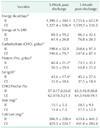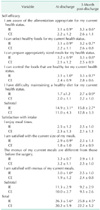1. International Agency for Research on Cancer. Globocan 2012: estimated cancer incidence, mortality and prevalence worldwide in 2012 – all cancers (excluding non-melanoma skin cancer) [Internet]. Lyon: International Agency for Research on Cancer;c2015. cited 2015 May 12. Available from:
http://globocan.iarc.fr/Pages/fact_sheets_cancer.aspx.
2. International Agency for Research on Cancer. Globocan 2012: Estimated cancer incidence, mortality and prevalence worldwide in 2012: Stomach cancer [Internet]. Lyon: International Agency for Research on Cancer;c2015. cited 2015 May 12. Available from:
http://globocan.iarc.fr/old/FactSheets/cancers/stomachnew.asp.
5. Yim JY, Kim N, Choi SH, Kim YS, Cho KR, Kim SS, et al. Seroprevalence of Helicobacter pylori in South Korea. Helicobacter. 2007; 12:333–340.
6. Jee SH, Samet JM, Ohrr H, Kim JH, Kim IS. Smoking and cancer risk in Korean men and women. Cancer Causes Control. 2004; 15:341–348.
7. Shin A, Kim J, Park S. Gastric cancer epidemiology in Korea. J Gastric Cancer. 2011; 11:135–140.
8. Kim HJ, Chang WK, Kim MK, Lee SS, Choi BY. Dietary factors and gastric cancer in Korea: a case-control study. Int J Cancer. 2002; 97:531–535.
9. Lee JK, Park BJ, Yoo KY, Ahn YO. Dietary factors and stomach cancer: a case-control study in Korea. Int J Epidemiol. 1995; 24:33–41.
11. Ryu SW, Kim IH. Comparison of different nutritional assessments in detecting malnutrition among gastric cancer patients. World J Gastroenterol. 2010; 16:3310–3317.
12. Oh CA, Kim DH, Oh SJ, Choi MG, Noh JH, Sohn TS, et al. Nutritional risk index as a predictor of postoperative wound complications after gastrectomy. World J Gastroenterol. 2012; 18:673–678.
13. Carey S, Storey D, Biankin AV, Martin D, Young J, Allman-Farinelli M. Long term nutritional status and quality of life following major upper gastrointestinal surgery: a cross-sectional study. Clin Nutr. 2011; 30:774–779.
14. Hirao M, Tsujinaka T, Takeno A, Fujitani K, Kurata M. Patient-controlled dietary schedule improves clinical outcome after gastrectomy for gastric cancer. World J Surg. 2005; 29:853–857.
15. Liu H, Ling W, Shen ZY, Jin X, Cao H. Clinical application of immune-enhanced enteral nutrition in patients with advanced gastric cancer after total gastrectomy. J Dig Dis. 2012; 13:401–406.
16. Kim H, Suh EE, Lee HJ, Yang HK. The effects of patient participation-based dietary intervention on nutritional and functional status for patients with gastrectomy: a randomized controlled trial. Cancer Nurs. 2014; 37:E10–E20.
17. Ottery FD. Definition of standardized nutritional assessment and interventional pathways in oncology. Nutrition. 1996; 12:S15–S19.
18. Ryan AM, Healy LA, Power DG, Rowley SP, Reynolds JV. Short-term nutritional implications of total gastrectomy for malignancy, and the impact of parenteral nutritional support. Clin Nutr. 2007; 26:718–727.
19. Park JY, Kim YJ. Successful laparoscopic reversal of gastric bypass in a patient with malnutrition. Ann Surg Treat Res. 2014; 87:217–221.
20. Yu EJ, Kang JH, Yoon S, Chung HK. Changes in nutritional status according to biochemical assay, body weight, and nutrient intake levels in gastrectomy patients. J Korean Diet Assoc. 2012; 18:16–29.
21. Carey S, Ferrie S, Ryan R, Beaton J, Young J, Allman-Farinelli M. Long-term nutrition intervention following major upper gastrointestinal surgery: a prospective randomized controlled trial. Eur J Clin Nutr. 2013; 67:324–329.
22. Jeong MJ, Kim CY, Kim SB. A study on nutritional status after gastrectomy of gastric cancer patients in Jeonbuk province. Korean J Community Nutr. 2006; 11:785–792.
23. Beattie AH, Prach AT, Baxter JP, Pennington CR. A randomised controlled trial evaluating the use of enteral nutritional supplements postoperatively in malnourished surgical patients. Gut. 2000; 46:813–818.
24. Na JR, Suh YS, Kong SH, Lim JH, Ju DL, Yang HK, et al. A prospective observational study evaluating the change of nutritional status and the incidence of dumping syndrome after gastrectomy. J Clin Nutr. 2014; 6:59–70.
25. Chen W, Zhang Z, Xiong M, Meng X, Dai F, Fang J, et al. Early enteral nutrition after total gastrectomy for gastric cancer. Asia Pac J Clin Nutr. 2014; 23:607–611.
26. Sun V, Kim J, Kim JY, Raz DJ, Merchant S, Chao J, et al. Dietary alterations and restrictions following surgery for upper gastrointestinal cancers: key components of a health-related quality of life intervention. Eur J Oncol Nurs. 2015; 19:343–348.
27. Carey S, Laws R, Ferrie S, Young J, Allman-Farinelli M. Struggling with food and eating--life after major upper gastrointestinal surgery. Support Care Cancer. 2013; 21:2749–2757.
28. Copland L, Liedman B, Rothenberg E, Bosaeus I. Effects of nutritional support long time after total gastrectomy. Clin Nutr. 2007; 26:605–613.
29. Tian J, Chen JS. Nutritional status and quality of life of the gastric cancer patients in Changle County of China. World J Gastroenterol. 2005; 11:1582–1586.
30. Song WJ, Kang KC, Heo YS, Shin SH. Comparison of short-term and long-term qualities of life after curative open gastrectomy in patients with gastric cancer. Korean J Clin Oncol. 2010; 6:12–19.








 PDF
PDF ePub
ePub Citation
Citation Print
Print





 XML Download
XML Download